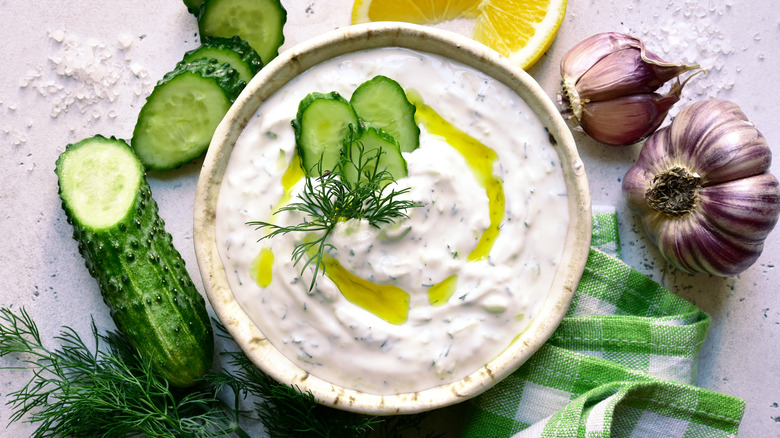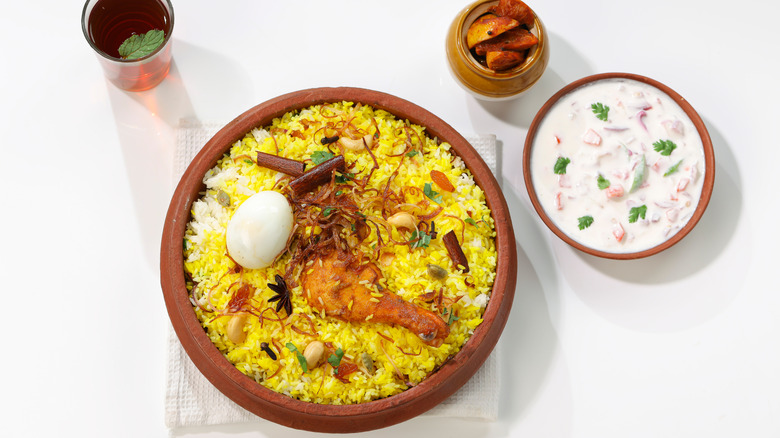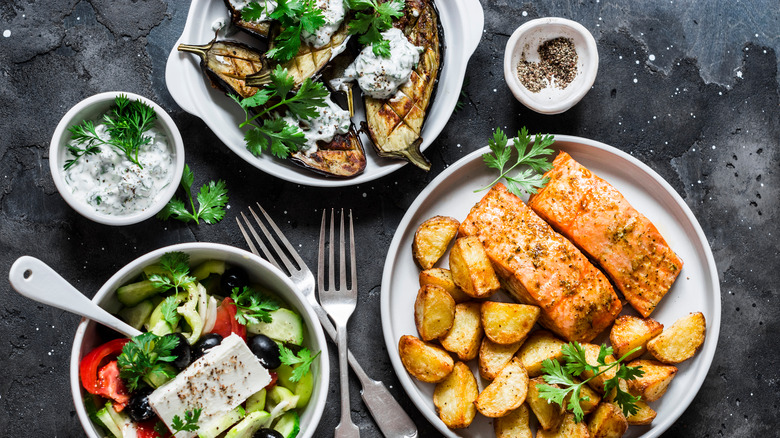Raita Vs. Tzatziki: What's The Difference?
If you've ever had souvlaki, with the pita still warm and the grilled meat or vegetables smoky and tender, you know it wouldn't be the same without a liberal dash of tzatziki co-mingling with the fresh tomatoes — and the subsequent dripping down your wrist as you take a bite. The sauce is fairly basic, but it's indispensable in souvlaki and many other Greek dishes you need to try at least once. The same is true for raita — a side dish that's an important addition to a vast array of Indian foods. Swasthi's Recipes calls it tzatziki's cousin because both condiments share yogurt as a distinctive component and serve a purpose as part of a meal.
However, each one is unique, meaning they're not interchangeable. For starters, they have dissimilar textures and levels of richness. Tzatziki, though traditionally made with strained sheep's or goat's milk yogurt, often has thick Greek yogurt as a base, per The Mediterranean Dish. On the other hand, raita uses regular yogurt or dahi (also known as Indian yogurt or curd) — depending on the recipe – as the vehicle for aromatic vegetables and spices. Let's take a look at some additional ways these two essential dips are similar but also different.
What's in raita?
The main function of raita, also called pachadi and curd dip, is to counteract the heat in spicy dishes. Serve it for a refreshing, cooling, and crunchy element alongside all manner of Indian foods like biryani, pulao, vegetable sabzi, and flatbreads such as roti or stuffed naan. But why stop there? Bon Appétit suggests you can enjoy raita by itself as a light bite or partner it with any non-Indian dish — anything from fried foods to meats to roasted vegetables.
The side dish comes in many variations, including regional ones. A simple version is South Indian onion raita, which includes onions, green chilis, and cilantro (via Swasthi's Recipes). Other recipes might make use of ingredients like cucumber, cabbage, garlic, sugar, cooked vegetables, fruit, and boondi — fried chickpea flour-based balls. It's easy to whip up a raita with prepared yogurt (non-dairy alternatives work too), but to make it taste as good as possible, use homemade curd and fresh ingredients and avoid over-spicing.
The most common seasonings are red chili powder, roasted cumin powder, and cilantro, but recipes often include chaat masala, part of a hot new food trend in 2023, and mint, per My Food Story. The ideal consistency for raita is creamy but not as thick as tzatziki, so a good rule of thumb to follow is a 2:1 ratio. For every two cups of yogurt, add one cup of vegetables and other ingredients you want to mix in.
What's in tzatziki?
In contrast to the many varieties of raita, tzatziki is generally a more straightforward combination of Greek yogurt, cucumber, garlic, some form of acid, salt, and pepper. Mint and dill are optional but make for a nice herbaceous foil for the grilled fish, meats, and vegetables popular in Greek cooking. And of course, an ample drizzle of olive oil would not be remiss. Because there are so few ingredients, they have to be top-notch (via Ask the Food Geek). While there are variations you could make with ingredients such as avocado, ranch dressing, cilantro, and lime, the results — though delicious — are not true tzatziki.
According to The Mediterranean Dish, tzatziki is a must-have item on any mezze platter — an embarrassment of riches featuring raw, pickled, and roasted vegetables, bread, olives, cured meat, feta cheese, and other dips like labneh and hummus. The condiment is also great to slather onto kebabs and gyros. Plus, as with raita, tzatziki goes well with foods that aren't traditional to its origins, such as burgers and grain bowls.
The dip is a quick and easy extra that packs a punch of cool, fresh, and garlicky flavor. But it's important to drain out excess water from the grated cucumbers before you stir them into your yogurt mixture; otherwise, your tzatziki will turn from luscious to runny before you can get it to the table.


